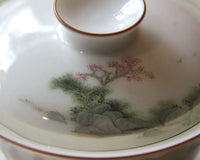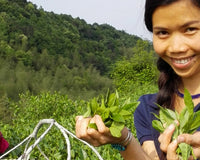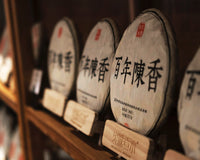Population: 41.5 million.
Area: 121,400 km2 (46,900 square miles).
Tea Production Area: 327.78万亩 ***,*** hm2 (*th Largest in China).
Tea Production Output: 4,610,000 tons (2019).
Tea Production Value: 23,722,000,000RMB / 237.22 亿元 (2019). [1]
Climate: Subtropical Monsoon (average annual temperature 15 - 18 degrees Celsius).
Tea Types: Fujian has the most diverse range of teas in China; oolong, black, white, and green.
Famous Teas: Wuyi Rock Teas (e.g. Shui Xian, Rou Gui, Bai Ji Guan etc.), Tie Guan Yin, Da Ye Oolong, Lapsang Souchong, Fuding white tea.
Notable Cultivars: **********
Tea Ware: De Hua 德化窑 porcelain
Fujian is one of the largest tea producing regions of China and home to some of the most renowned teas too.
With almost 80% of Taiwanese being able to trace their ancestry back to Fujian, it is no wonder that Taiwan is also a world-renowned source of delightful teas.
Almost everywhere you travel in Fujian you will find tea preparation in evidence, whether in the street or in a restaurant - but almost certainly in every home.
Anxi
Anxi, in southern Fujian (Minnan 闽南) - Wan Ling's home town - is a two hours' bus journey from Xiamen. Anxi is both a city and a county, both belonging to the administrative city of Quanzhou 泉州.
Anxi is the original home of Tie Guan Yin oolong tea. The Tie Guan Yin plants are reputed to have been found near a temple in the village of Xi Ping. Anxi produces a vast number of oolong teas with names that relate either to the local village or place where they are produced, to the plant's characteristics or, as with Tie Guan Yin, to a fabled story.
Well-known Minnan oolongs include: Mao Xie 毛蟹 (Hairy Crab), Huang Jin Gui 黄金桂, Da Ye 大叶 (large leaf), Se Zhong, Mei Zhan 梅占 and the famous Ben Shan tea trees.
Tea has been subject to changing fashions over the centuries. For example, from the 1950s onwards Anxi had three main tea styles: Se Zhong, Tie Guan Yin and oolong (Mei Zhan, Ben Shan, Mao Xie and Fou Shou were all included within the 'Se Zhong' category). The name Huang Dan has now become Huang Jin Gui.
In the mid- to late eighties there was a trend towards a Qing Xiang style (green, lightly-oxidised to 20% - 40% and highly fragrant Anxi tea), to the degree that it is difficult to find anything else. Previously, the more highly oxidised teas (50% - 90%) had been popular.
Tea drinking in Anxi is a vital part of daily life, festivals and all key events. When getting married in Anxi, the new bride must make tea for the groom's immediate family in return for a Hong Bao or red packet (a gift that contains money). Tea and tea leaves are used in prayer are offered up to Buddha, local Daoist deities and to honour deceased relatives.
Dehua
Dehua is famous for its fine white porcelain. Such porcelain is ideal for tea cups and gaiwans, which are used extensively throughout Fujian for preparing tea in the gongfu style.
Zhenghe and Fuding
The north of Fujian is home to Zhenghe county 政和县 and Fuding city 福鼎市.
Zhenghe is closer to Wuyi than Fuding and is sandwiched between two mountain chains (Wuyi 武夷山 and Jiufeng 九峰山). Zhenghe experiences colder winters than coastal Fuding. Fuding has a milder, maritime climate with more rainfall and greater humidity.
Zhenghe (Minbei 闽北) and Fuding (Mindong 闽东) are the two main white tea producing regions in China. Traditional processing styles vary slightly between the two; Zhenghe favours natural indoor withering whilst Fuding tea makers commonly employ a combination of both indoor and outdoor (solar/sun) withering.
The total growing area in Fuding dwarfs that of Zhenghe's, producing more than double the volume.
Zhenghe Dabai 大白 and Fuding Dabai 大白 are the cultivars of choice for both districts; the latter is known for its superior 'downy' aroma and flavour, the former for full-bodied liquors. Due to the upturn in the domestic white tea market, production has now spread into other tea-producing regions, such as Guizhou and Yunnan, though yield and quality in these areas remain inconsistent. The best white teas are still produced in the traditional regions of Fujian.
Fuzhou
Fuzhou is Fujian's provincial capital, with a long and remarkable history. Fuzhou and the nearby county of Fuding are renowned for their production of flower teas, in particular jasmine tea.
Wuyi Shan 武夷山 / Wuyi Mountains
Wuyi Mountains are a protected UNESCO World Heritage Site covering around 128,000 hectares, including a core site of 63,000 hectares where no development is allowed. The region is located in the northern part of Fujian, known as Min Bei (northern Min region). It lies alongside the border to Jiangxi province.
Wuyi Rock Tea / Yan Cha 岩茶
The Wuyi mountainous area is one of the largest producers of tea; it is home to Rock Tea (Yan Cha 岩茶). Amongst the most renowned types of Rock Tea are: Ming Cong, Da Hong Pao, Bai Ji Guan, Shui Jin Gui and Tie Luo Han.
Wuyi Mountain Culture
According to UNESCO the Wuyi mountains incorporate and protect many ancient temples. These include Taoyuan Temple, the Wannian Palace, the Sanqing Hall, the Tiancheng Temple, the Baiyun temple, and the Tianxin temple. All of these have survived to varying degrees of authenticity. There is also a number of tombs, the oldest dating back to the Shang Dynasty (late 2nd millennium BCE).
The Wuyi mountains can trace civilisation back 4000 years. The region is also known by many as the 'Cradle of Neo-Confucianism'. Zhu Xi (1130-1200) was a follower of Confucian teachings and spent much of his life there studying, teaching and developing what was to become the dominant intellectual theory from the Song to the Qing Dynasties (10th to 19th centuries). The Wuyi mountains attracted a wide range of artists, theologians and spiritualists and the region also became particularly popular with Taoists and Buddhists.
Over the centuries the Wuyi Mountains have had the protection of various royal decrees from emperors dating back as far as the Tang Emperor Xuan Zong in AD 748, who used his influence to control forestry and fishing so that the beauty of the area could be maintained.
Wuyi Mountain Tea Culture
The tea culture of the Wuyi mountains can be traced back to 11th century. For nearly five centuries there was an Imperial tea farm producing teas for the emperor and the imperial court.
Even today, monks living in the temples cultivate and harvest tea. Among their ranks there are a chosen few who craft the rare official Da Hong Pao blend.
Tea culture is still shaping Wuyi today; Wuyi town, separated from the UNESCO site by a river, is growing rapidly due to tea tourism. Yan Cha and Da Hong Pao are synonymous with the area and the town is packed with tea shops selling Rock Tea, although much is actually brought in from farms outside the official growing area.
Mount Wuyi Environment
Due to the location of the Wuyi mountains and its long-term protected status, it is no surprise to learn that it is also home to a wide variety of diverse flora and fauna, including a number of IUCN Red Listed animals and plants.
The Wuyi mountains are one of the largest and best preserved areas of humid subtropical forests in the world. Eleven broad vegetation patterns are found here, including shrub forest, brushwood and meadow steppe. The area is one of considerable geological and geomorphological interest too, as the region has been shaped by intensive volcanic activity and large fault structures.
The region's climate has also played its part in shaping the landscape by forming winding streams, dome-shaped cliffs and numerous caves.
According to UNESCO there are 49 species of invertebrates found in the region, and amongst those that are endemic to China there are three species that are endemic to the Wuyi mountains itself: David's Parrot Bill bird, and two amphibians. Other rare and important species in the area of Mount Wuyi include Chinese tiger, clouded leopard, leopard, black muntjac, mainland serow, Chinese black-backed pheasant and Chinese giant salamander.












